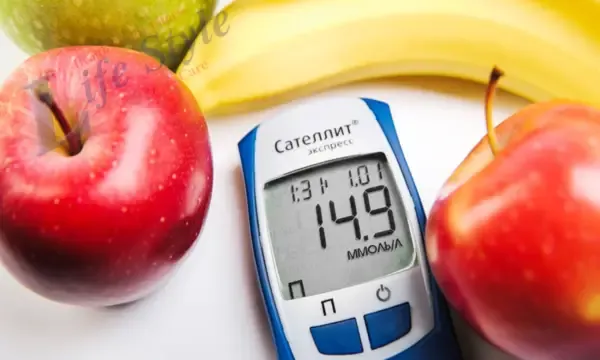Some types of fruits are referred to as the most dangerous fruits for diabetics, for several reasons, the most important of which is their high sugar content and high glycemic index; which means a rapid and sudden rise in blood sugar when consumed.
Therefore, it is generally recommended that diabetics avoid or limit their consumption, especially if they have problems keeping blood sugar under control.
Learn in this article about the properties of fruits that are recommended to be avoided for diabetics, as well as 8 of the most dangerous fruits for diabetics.
Read More
Diabetes. symptoms signs type 1 type 2 avoid, manage, and treat.
Vitamin B. Health benefits, sources, and symptoms of deficiency
Fruits that are recommended to avoid for diabetics
Although fruits are generally considered healthy, they are not equally healthy, especially for diabetics. For example, fresh or frozen fruit or natural fruit juice is better than processed fruit products or fruit juice packaged in metal or plastic containers, as these products often contain added sugar.
Also, the carbohydrate content, natural sugar fructose, and glycemic index differ between different types of fruits, so these differences must be taken into account when eating fruits to maintain a balanced diet suitable for the health situation of a diabetic patient.
Here are two groups of types of fruit that are recommended for diabetics to avoid or eat in a measured way:
High-carbohydrate fruits
The amount of carbohydrates eaten by individuals is the biggest influencing factor on blood sugar levels. Therefore, diabetics should calculate the number of carbohydrates contained in fruit servings within the number of carbohydrates set for them per day.
It should also be taken into account that the percentage of carbohydrates in one serving of fruit varies depending on the type, for example, all the following servings of fruits, despite the difference in serving size, contain 15 grams of carbohydrates:
Half an apple of medium size.
Half a medium-sized banana.
One glass of black raspberries or spiny ground berries.
Three-quarters of a glass of blueberries.
One glass of watermelon cubes.
One-eighth of a glass of raisins.
Fruits with a high glycemic index
The glycemic index indicates how quickly blood sugar rises when eating a food, which is why fruits with a medium to high glycemic index are not the best choice for diabetics and people with insulin resistance.
The glycemic index scale ranges from 1-100 as follows:
Low glycemic index: from 1-55.
Average glycemic index: from 56-69.
High glycemic index: from 70-100.
Here are some examples of fruits that have an average or high glycemic index:
The manga.
Ripe bananas.
Pineapple.
Watermelon.
The fruits that diabetics should avoid the most
The following are the types of fruits that are the worst for diabetics because they contain a high percentage of sugar and may cause a disturbance in the blood sugar level when consumed excessively or unbalanced with the daily nutritional plan:
Pineapple: one pineapple (905 grams) contains 89 grams of sugar. And one slice of pineapple fruit (84 grams) contains 8 grams of sugar.
Mango: one mango (336 grams) contains 46 grams of sugar. A serving of chopped manga (100 grams) contains 13.7 grams of sugar.
Figs: a serving of undried figs (100 grams) contains 16 grams of sugar, in turn, a similar serving of dried figs contains 47.9 grams of sugar.
Kiwi: a kiwi fruit (69 grams) contains 6.2 grams of sugar.
Cherries: a serving of sour raw cherries (100 grams) contains 8.49 grams of sugar.
Tangerines: a medium-sized fruit of Mandarin (88 grams) contains 9.33 grams of sugar.
Raisins: a serving of seedless black raisins (14 grams) contains 9 grams of sugar.
Dried fruits: in general, dried fruits contain sugars at higher rates compared to fresh fruits, due to the removal of much of their water content during the drying process or due to the addition of some sugar to them to soften their pungent taste after drying.
Here are some examples of dried fruits:
Sweetened dried cherries: contains 67% more sugar.
Dried cranberries: contains 65% more sugar.
Dried figs: contains 48% higher sugar content.
Dried plums: they contain 38% more sugar.
Also read: forbidden foods for people with diabetes
The number of fruits allowed for diabetics
Unless the doctor or nutritionist recommends otherwise, a diabetic patient can eat fruit at the rate of one serving per meal, taking into account the size and type of fruit. Among the dietary recommendations for diabetics in choosing the most suitable fruit are the following:
Eat fruit with a low glycemic index, such as an Apple.
Take into account that one serving of fruit contains no more than 15 grams of carbohydrates.
Eat fresh and frozen fruit instead of processed or processed whenever possible.
Avoid taking the fruit portion in the form of juice, as the juice of a fruit contains higher carbohydrates and less fiber compared to the fruit portion of the fruit itself.
Monitor the serving size of the fruit, especially in the case of eating dried or pre-packaged fruit, and read the nutritional label to determine the appropriate serving size according to its sugar and carbohydrate content.
Distribute fruit servings throughout the day.
Diversify between types of fruits, to get their diverse and many benefits, such as preventing heart disease.

